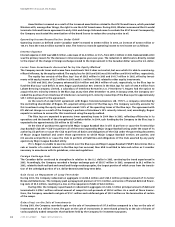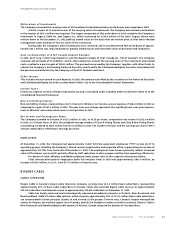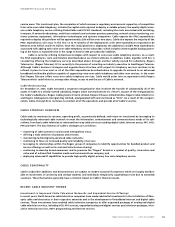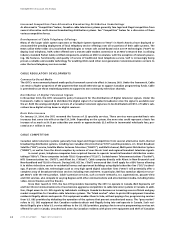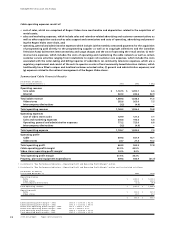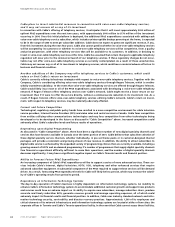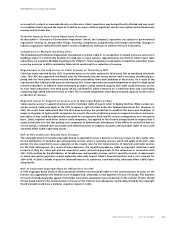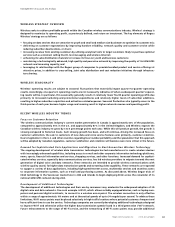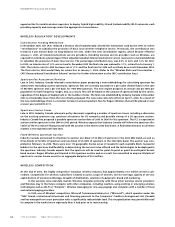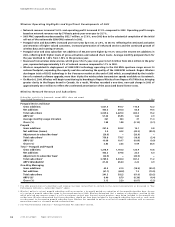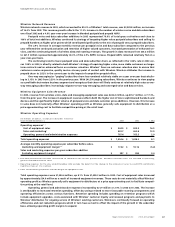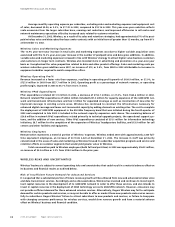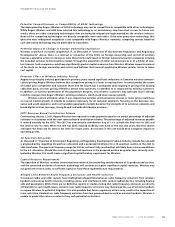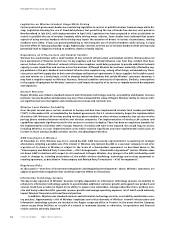Rogers 2003 Annual Report Download - page 42
Download and view the complete annual report
Please find page 42 of the 2003 Rogers annual report below. You can navigate through the pages in the report by either clicking on the pages listed below, or by using the keyword search tool below to find specific information within the annual report.
2003 Annual Report Rogers Communications Inc.
40
Cable plans to invest substantial resources in connection with voice-over-cable telephony services,
and it may not recover all or any of its investment
In connection with Cable’s offering of telephony services, it anticipates that it will invest approximately $200 million of
upfront PP&E expenditures over the next two years, with approximately $140 million to $170 million of the investment
occurring in 2004. Once this initial platform is deployed, the additional PP&E expenditures associated with adding each
voice-over-cable telephony service subscriber, which includes uninterruptible backup powering at the home, is expected
to be in the range of $300 to $340 per subscriber addition. Cable does not expect to generate significant revenue, if any,
from this investment during the next few years. Cable also cannot predict whether its voice-over-cable telephony services
will be accepted by its customers or whether its voice-over-cable telephony services will be competitive, from a quality
and price perspective, with other telephony services that will be available to its customers. In addition, in deciding to
invest in voice-over-cable telephony services at this time, Cable has assumed that certain changes to applicable telephony
regulation will occur prior to the commercial launch of our telephony services. If these regulatory changes do not occur,
Cable may not offer voice-over-cable telephony services as currently contemplated. As a result of these uncertainties,
Cable may not recover any or all of its investment in telephony services, which could have a material adverse effect on its
business and financial condition.
Another subsidiary of the Company may offer telephony services to Cable’s customers, which could
reduce or limit Cable’s return on investment
Cable is currently refining its business strategies with respect to voice-over-cable telephony services. Together with the
Company, Cable is considering offering voice-over-cable telephony services through Rogers Telecom, which is another
wholly-owned RCI subsidiary. In the event that voice-over-cable telephony services are offered through Rogers Telecom,
Cable would likely incur most or all of the PP&E expenditures associated with developing a voice-over-cable telephony
network. If Rogers Telecom offers telephony services over Cable’s network, Cable might receive a lower return on our
investment than if it were to offer the service directly, without a commensurate reduction in its investment risk. As a
result, if Rogers Telecom offers voice-over-cable telephony services utilizing Cable’s network, Cable’s return on invest-
ment, with respect to telephony services, may be materially adversely affected.
Current and Future Competition
Technological, regulatory and public policy trends have resulted in a more competitive environment for cable television
service providers, Internet Service Providers (ISPs) and video sales and rental services in Canada. Cable faces competition
from entities utilizing other communications technologies and may face competition from other technologies being
developed or to be developed in the future as discussed in “Cable Competition” above. Increased competition could
adversely affect Cable’s subscriber levels and future results of operations.
Dependency upon Digital Programming
As discussed in “Cable Competition” above, there have been a significant number of new digital specialty channels and
services that have become available in Canada since the latter portion of 2001. Cable believes that subscriber selection of
these digital specialty service channels, whether individually, in pre-set theme packs or in customer-designed channel
packages, will provide a consistent and growing stream of new revenue. In addition, the ability to attract subscribers to
digital cable service is enhanced by the expanded variety of programming choices that are currently available, including a
growing amount of HDTV and on-demand programming. If a number of programmers that supply digital specialty channels
face financial or operational difficulty sufficient to cease their operations, and the number of digital specialty channels
decreases significantly, it may have a significant negative impact on Cable’s financial results and financial position.
Ability to Forecast Future PP&E Expenditures
An increasing component of Cable’s PP&E expenditures will be to support a series of more advanced services. These ser-
vices include Cable’s Internet, digital television, HDTV, VOD, telephony and other enhanced services that require
advanced subscriber equipment. A substantial component of the PP&E required to support these services will be demand
driven. As a result, forecasting PP&E expenditure levels for Cable will likely be less precise, which may increase the volatil-
ity of Cable’s operating results from period to period.
Dependency on Information Technology Systems
The day-to-day operation of Cable’s business is highly dependent on information technology systems. An inability to
enhance Cable’s information technology systems to accommodate additional customer growth and support new products
and services could have an adverse impact on its ability to acquire new subscribers, manage subscriber churn, produce
accurate and timely subscriber bills, generate revenue growth and manage operating expenses, all of which could
adversely impact its financial results and financial position. In addition, Cable uses industry standard network and infor-
mation technology security, survivability and disaster recovery practices. Approximately 1,300 of its employees and
critical elements of its network infrastructure and information technology systems are located at either of two sites: the
corporate offices in Toronto and Cable’s Toronto operations facility. In the event that Cable cannot access these facilities,
Management’s Discussion and Analysis


